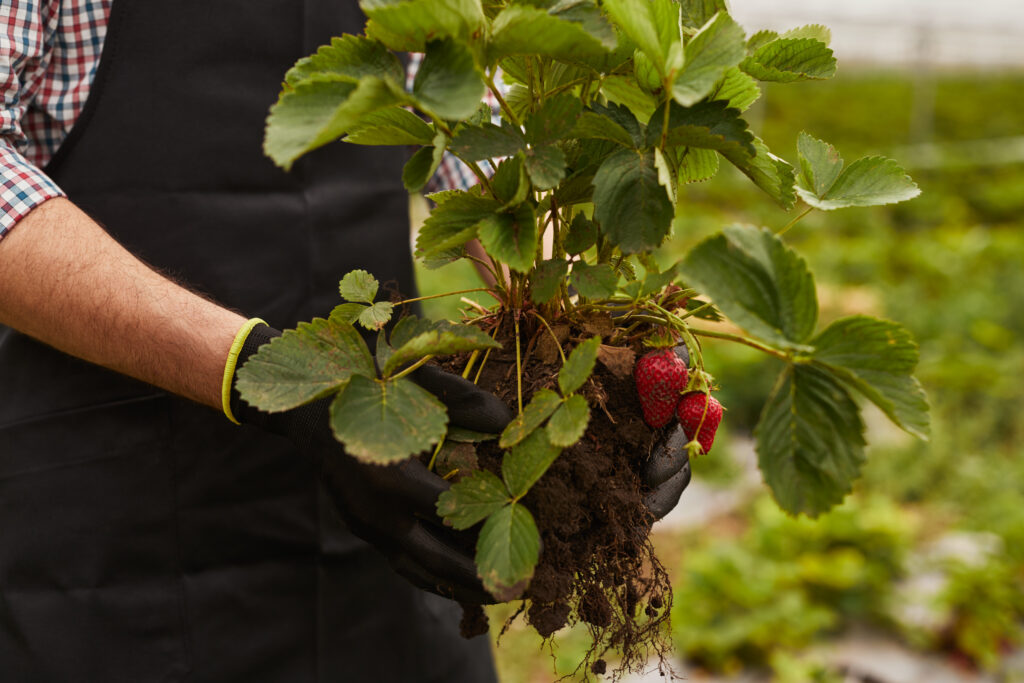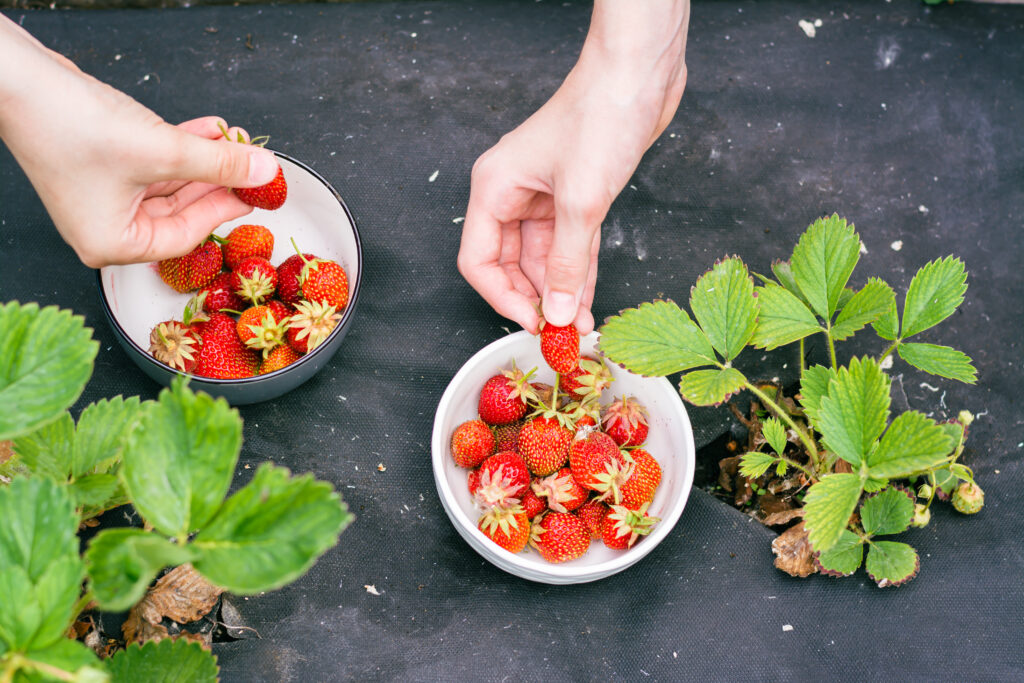Introduction
Strawberries are one of the most rewarding fruits you can grow in your garden. Sweet, juicy, and packed with flavor, they are perfect for homemade jams, desserts, and fresh snacks. Growing strawberries at home ensures you get the freshest fruits while saving money. Plus, there’s something incredibly satisfying about plucking ripe strawberries directly from your garden.
In this guide, we’ll cover everything you need to know about growing strawberries in your garden, from planting to harvest. We’ll explore the different types of strawberries, ideal growing conditions, and expert tips for abundant yields.

Why Grow Strawberries in Your Garden?
Growing strawberries in your garden comes with several advantages:
Freshness: Store-bought strawberries often lack the natural sweetness you get from homegrown berries. Garden strawberries are free from preservatives, pesticides, and artificial growth enhancers.
Cost Savings: A few strawberry plants can produce a significant number of berries over the growing season, saving you money compared to purchasing them from the grocery store.
Fun and Family-Friendly: Strawberries are easy to grow and are a fun gardening project for both adults and kids. Watching the plants bloom and bear fruit is incredibly satisfying.
Sustainability: Growing your own strawberries reduces packaging waste and the carbon footprint associated with transporting produce. Plus, you can grow them organically without harmful chemicals.
Choosing the Right Type of Strawberries
There are three main types of strawberries to consider for your garden:
June-bearing Strawberries: These produce a large crop once a year, usually in late spring or early summer. They’re ideal if you want a big harvest for jams or freezing.
Ever-bearing Strawberries: As the name suggests, ever-bearing strawberries produce multiple crops throughout the growing season—one in early summer, another in late summer, and sometimes a small third harvest in early fall.
Day-neutral Strawberries: These produce smaller but steady harvests from late spring to early fall, as long as temperatures stay between 2°C to 29°C. Day-neutral varieties are great if you prefer a consistent supply of strawberries.
Preparing the Soil
Strawberries thrive in well-draining, slightly acidic soil with a pH between 5.5 and 6.8. Before planting, test your soil’s pH level to ensure it’s suitable for strawberries. If the pH is too high, you can lower it by adding organic matter such as peat moss or compost.
Make sure the soil is rich in nutrients. Strawberries benefit from a soil mix with plenty of organic compost, aged manure, or balanced fertilizers.
Ideal Soil Conditions:
- pH Level: 5.5-6.8
- Well-draining soil
- Rich in organic matter
Choosing the Perfect Location
Strawberries need full sunlight to produce the best fruit. Aim for a spot that gets at least 6-8 hours of direct sunlight every day. Avoid areas with heavy shade or where water tends to pool, as this can lead to root rot or other diseases.
Tips for Selecting a Location:
- Full Sun: 6-8 hours of direct sunlight.
- Well-Drained Area: Avoid low spots in your garden where water may collect.
- Raised Beds or Containers: Consider using raised beds or containers if your soil drainage is poor.
Planting Strawberries

When to Plant
The best time to plant strawberries depends on your region, but for most areas, early spring is ideal. Planting in spring gives your plants time to establish themselves before the growing season starts.
How to Plant Strawberries
- Spacing: Space plants about 12-18 inches apart to give them room to spread.
- Depth: Ensure that the crowns (where the leaves meet the roots) are at soil level, not buried.
- Mulching: After planting, mulch around the plants to keep moisture in and reduce the risk of weeds.
Strawberry Plants Layouts:
- Matted Row System: Common for June-bearing strawberries. Allow the runners (new shoots) to root and form a thick mat.
- Hill System: More suited for ever-bearing and day-neutral varieties. It focuses on preventing runners from rooting, focusing energy on the mother plant.
Caring for Strawberry Plants
Watering
Strawberries need consistent moisture, especially when they’re flowering and fruiting. Water deeply but avoid waterlogging the soil. A general rule is to provide about 1 inch of water per week, adjusting based on rainfall.
Fertilizing
Strawberries benefit from regular feeding, but avoid over-fertilizing as it can lead to lush foliage with fewer fruits. Use a balanced fertilizer before planting and follow up with a side dressing of compost or a balanced fertilizer every four weeks during the growing season.
Mulching
Mulch is critical for strawberries. It helps retain soil moisture, suppress weeds, and keep the soil temperature stable. Straw, shredded leaves, or wood chips work well for strawberries.
Dealing with Pests and Diseases
Strawberries are vulnerable to a range of pests and diseases, including aphids, slugs, and fungal infections like gray mold (Botrytis). Here’s how to protect your plants:
Use Organic Pest Control: Introduce beneficial insects like ladybugs to control aphids. For slugs, use barriers or organic pellets.
Fungal Diseases: Avoid overhead watering to reduce the risk of mold. If you notice mold or rot on your berries, remove affected fruit immediately.
Netting: Protect your strawberries from birds by covering the plants with netting as the fruits begin to ripen.
Harvesting Your Strawberries

Strawberries are ready to harvest when they are fully red and slightly soft to the touch. For the best flavor, pick them in the morning when they’re still cool from the night air.
Harvest strawberries by cutting them off with the stem intact rather than pulling them off the plant. This helps the plant stay healthy and continue producing fruit.
Extending the Growing Season
With the right care, you can extend the strawberry growing season beyond the standard harvest period.
Use Row Covers: Light row covers can protect your strawberries from frost, allowing for an extended harvest.
Grow Indoors: If you live in an area with harsh winters, consider growing strawberries indoors in pots, placing them in a sunny windowsill.
Companion Planting
Winter Care for Strawberries
In colder climates, strawberries need protection over the winter. After the growing season ends, apply a thick layer of straw mulch to insulate the plants from freezing temperatures.
In milder climates, you might not need as much winter care, but it’s still a good idea to add some mulch to protect the plants and ensure a strong crop next season.
Enjoying Your Homegrown Strawberries
Growing your own strawberries isn’t just a fun and rewarding gardening project—it’s a way to enjoy fresh, delicious, and organic fruit right from your garden. Whether you’re eating them fresh, adding them to salads, or using them in desserts, homegrown strawberries are tastier and healthier than store-bought options.
By following this guide, you’ll be well on your way to growing a productive strawberry patch. With just a little bit of care, you’ll enjoy a bountiful harvest of sweet, juicy strawberries year after year.

